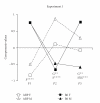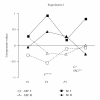Anxiety in mice: a principal component analysis study
- PMID: 17502910
- PMCID: PMC1847470
- DOI: 10.1155/2007/35457
Anxiety in mice: a principal component analysis study
Abstract
Two principal component analyses of anxiety were undertaken investigating two strains of mice (ABP/Le and C57BL/6ByJ) in two different experiments, both classical tests for assessing anxiety in rodents. The elevated plus-maze and staircase were used for the first experiment, and a free exploratory paradigm and light-dark discrimination were used for the second. The components in the analyses produced definitions of four fundamental behavior patterns: novelty-induced anxiety, general activity, exploratory behavior, and decision making. We also noted that the anxious phenotype was determined by both strain and experimental procedure. The relationship between behavior patterns and the use of specific tests plus links with the genetic background are discussed.
Figures


Similar articles
-
Assessment of mouse anxiety-like behavior in the light-dark box and open-field arena: role of equipment and procedure.Physiol Behav. 2014 Jun 22;133:30-8. doi: 10.1016/j.physbeh.2014.05.006. Epub 2014 May 14. Physiol Behav. 2014. PMID: 24832050
-
Three murine anxiety models: results from multiple inbred strain comparisons.Genes Brain Behav. 2008 Jun;7(4):496-505. doi: 10.1111/j.1601-183X.2007.00385.x. Epub 2007 Dec 26. Genes Brain Behav. 2008. PMID: 18182070
-
Contrasting phenotypes of C57BL/6JOlaHsd, 129S2/SvHsd and 129/SvEv mice in two exploration-based tests of anxiety-related behaviour.Physiol Behav. 2002 Nov;77(2-3):301-10. doi: 10.1016/s0031-9384(02)00856-9. Physiol Behav. 2002. PMID: 12419406
-
Models of anxiety: responses of mice to novelty and open spaces in a 3D maze.Behav Brain Res. 2006 Nov 1;174(1):9-38. doi: 10.1016/j.bbr.2006.07.001. Epub 2006 Aug 17. Behav Brain Res. 2006. PMID: 16919819
-
Galanin GAL-R1 receptor null mutant mice display increased anxiety-like behavior specific to the elevated plus-maze.Neuropsychopharmacology. 2003 Jun;28(6):1031-44. doi: 10.1038/sj.npp.1300164. Epub 2003 Apr 9. Neuropsychopharmacology. 2003. PMID: 12700679
Cited by
-
Stress, genotype and norepinephrine in the prediction of mouse behavior using reinforcement learning.Nat Neurosci. 2009 Sep;12(9):1180-6. doi: 10.1038/nn.2374. Epub 2009 Aug 16. Nat Neurosci. 2009. PMID: 19684590
-
The active alkaloids of Gelsemium elegans Benth. are potent anxiolytics.Psychopharmacology (Berl). 2013 Feb;225(4):839-51. doi: 10.1007/s00213-012-2867-x. Epub 2012 Oct 5. Psychopharmacology (Berl). 2013. PMID: 23052566
-
Pharmacological alterations of anxious behaviour in mice depending on both strain and the behavioural situation.PLoS One. 2009 Nov 11;4(11):e7745. doi: 10.1371/journal.pone.0007745. PLoS One. 2009. PMID: 19907641 Free PMC article.
-
Dose-effect study of Gelsemium sempervirens in high dilutions on anxiety-related responses in mice.Psychopharmacology (Berl). 2010 Jul;210(4):533-45. doi: 10.1007/s00213-010-1855-2. Epub 2010 Apr 20. Psychopharmacology (Berl). 2010. PMID: 20401745 Free PMC article.
-
Assessing Affective State in Laboratory Rodents to Promote Animal Welfare-What Is the Progress in Applied Refinement Research?Animals (Basel). 2019 Nov 25;9(12):1026. doi: 10.3390/ani9121026. Animals (Basel). 2019. PMID: 31775293 Free PMC article. Review.
References
-
- Crawley JN, Goodwin FK. Preliminary report of a simple animal behavior model for the anxiolytic effects of benzodiazepines. Pharmacology Biochemistry and Behavior. 1980;13(2):167–170. - PubMed
-
- Rodgers RJ, Cao BJ, Dalvi A, Holmes A. Animal models of anxiety: an ethological perspective. Brazilian Journal of Medical and Biological Research. 1997;30(3):289–304. - PubMed
-
- Sánchez C. 5-HT1A receptors play an important role in modulation of behavior of rats in a two-compartment black and white box. Behavioural Pharmacology. 1996;7(8):788–797. - PubMed
-
- Griebel G, Belzung C, Misslin R, Vogel E. The free-exploratory paradigm: an effective method for measuring neophobic behaviour in mice and testing potential neophobia-reducing drugs. Behavioural Pharmacology. 1993;4(6):637–644. - PubMed
-
- Shimada T, Matsumoto K, Osanai M, Matsuda H, Terasawa K, Watanabe H. The modified light/dark transition test in mice: evaluation of classic and putative anxiolytic and anxiogenic drugs. General Pharmacology. 1995;26(1):205–210. - PubMed
Publication types
MeSH terms
LinkOut - more resources
Full Text Sources
Medical

